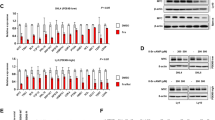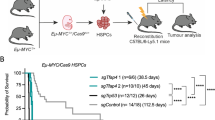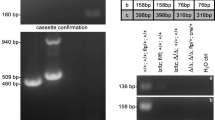Abstract
The effect of p53-dependent cell-cycle arrest and senescence on Eμ-myc-induced B-cell lymphoma development remains controversial. To address this question, we crossed Eμ-myc mice with the p53515C mutant mouse, encoding the mutant p53R172P protein that retains the ability to activate the cell-cycle inhibitor and senescence activator p21. Importantly, this mutant lacks the ability to activate p53-dependent apoptotic genes. Hence, Eμ-myc mice that harbor two p53515C alleles are completely defective for p53-dependent apoptosis. Both Eμ-myc::p53515C/515C and Eμ-myc::p53515C/+ mice survive significantly longer than Eμ-myc::p53+/– mice, indicating the importance of the p53-dependent non-apoptotic pathways in B-cell lymphomagenesis. In addition, the p53515C allele is deleted in several Eμ-myc::p53515C/+ lymphomas, further emphasizing the functionality of p53R172P in tumor inhibition. Lymphomas from both Eμ-myc::p53515C/515C and Eμ-myc::p53515C/+ mice retain the ability to upregulate p21, resulting in cellular senescence. Senescence-associated β-galactosidase (SA β-gal) activity was observed in lymphomas from Eμ-myc::p53+/+, Eμ-myc::p53515C/515C and Eμ-myc::p53515C /+ mice but not in lymphomas isolated from Eμ-myc::p53+/– mice. Thus, in the absence of p53-dependent apoptosis, the ability of p53R172P to induce senescence leads to a significant delay in B-cell lymphoma development.
This is a preview of subscription content, access via your institution
Access options
Subscribe to this journal
Receive 50 print issues and online access
$259.00 per year
only $5.18 per issue
Buy this article
- Purchase on Springer Link
- Instant access to full article PDF
Prices may be subject to local taxes which are calculated during checkout







Similar content being viewed by others
References
Adams JM, Harris AW, Pinkert CA, Corcoran LM, Alexander WS, Cory S et al. (1985). The c-myc oncogene driven by immunoglobulin enhancers induces lymphoid malignancy in transgenic mice. Nature 318: 533–538.
Bandara LR, La Thangue NB . (1991). Adenovirus E1a prevents the retinoblastoma gene product from complexing with a cellular transcription factor. Nature 351: 494–497.
Barboza JA, Liu G, Ju Z, El-Naggar AK, Lozano G . (2006). p21 delays tumor onset by preservation of chromosomal stability. Proc Natl Acad Sci USA 103: 19842–19847.
Beenken SW, Karsenty G, Raycroft L, Lozano G . (1991). An intron binding protein is required for transformation ability of p53. Nucleic Acids Res 19: 4747–4752.
Brown JP, Wei W, Sedivy JM . (1997). Bypass of senescence after disruption of p21CIP1/WAF1 gene in normal diploid human fibroblasts. Science 277: 831–834.
Dimri GP, Lee X, Basile G, Acosta M, Scott G, Roskelley C et al. (1995). A biomarker that identifies senescent human cells in culture and in aging skin in vivo. Proc Natl Acad Sci USA 92: 9363–9367.
Eischen CM, Roussel MF, Korsmeyer SJ, Cleveland JL . (2001). Bax loss impairs Myc-induced apoptosis and circumvents the selection of p53 mutations during Myc-mediated lymphomagenesis. Mol Cell Biol 21: 7653–7662.
Eischen CM, Weber JD, Roussel MF, Sherr CJ, Cleveland JL . (1999). Disruption of the ARF-Mdm2-p53 tumor suppressor pathway in Myc-induced lymphomagenesis. Genes Dev 13: 2658–2669.
el-Deiry WS, Tokino T, Velculescu VE, Levy DB, Parsons R, Trent JM et al. (1993). WAF1, a potential mediator of p53 tumor suppression. Cell 75: 817–825.
Feldser DM, Greider CW . (2007). Short telomeres limit tumor progression in vivo by inducing senescence. Short telomeres limit tumor progression in vivo by inducing senescence. Cancer Cell 11: 461–469.
Gu Y, Turck CW, Morgan DO . (1993). Inhibition of CDK2 activity in vivo by an associated 20K regulatory subunit. Nature 366: 707–710.
Harper JW, Adami GR, Wei N, Keyomarsi K, Elledge SJ . (1993). The p21 Cdk-interacting protein Cip1 is a potent inhibitor of G1 cyclin-dependent kinases. Cell 75: 805–816.
Hsu B, Marin MC, el-Naggar AK, Stephens LC, Brisbay S, McDonnell TJ . (1995). Evidence that c-myc mediated apoptosis does not require wild-type p53 during lymphomagenesis. Oncogene 11: 175–179.
Jacks T, Remington L, Williams BO, Schmitt EM, Halachmi S, Bronson RT et al. (1994a). Tumor spectrum analysis in p53-mutant mice. Curr Biol 4: 1–7.
Jacks T, Remington L, Williams BO, Schmitt EM, Halachmi S, Bronson RT et al. (1994b). Tumor spectrum analysis in p53-mutant mice. Curr Biol 4: 1–7.
Ko LJ, Prives C . (1996). p53: puzzle and paradigm. Genes Dev 10: 1054–1072.
Kulju KS, Lehman JM . (1995). Increased p53 protein associated with aging in human diploid fibroblasts. Exp Cell Res 217: 336–345.
Liu G, Parant JM, Lang G, Chau P, Chavez-Reyes A, El-Naggar AK et al. (2004). Chromosome stability, in the absence of apoptosis, is critical for suppression of tumorigenesis in Trp53 mutant mice. Nat Genet 36: 63–68.
Ludwig RL, Bates S, Vousden KH . (1996). Differential activation of target cellular promoters by p53 mutants with impaired apoptotic function. Mol Cell Biol 16: 4952–4960.
Martins CP, Berns A . (2002). Loss of p27(Kip1) but not p21(Cip1) decreases survival and synergizes with MYC in murine lymphomagenesis. EMBO J 21: 3739–3748.
Missero C, Di Cunto F, Kiyokawa H, Koff A, Dotto GP . (1996). The absence of p21Cip1/WAF1 alters keratinocyte growth and differentiation and promotes ras-tumor progression. Genes Dev 10: 3065–3075.
Noda A, Ning Y, Venable SF, Pereira-Smith OM, Smith JR . (1994). Cloning of senescent cell-derived inhibitors of DNA synthesis using an expression screen. Exp Cell Res 211: 90–98.
Pantoja C, Serrano M . (1999). Murine fibroblasts lacking p21 undergo senescence and are resistant to transformation by oncogenic Ras. Oncogene 18: 4974–4982.
Rowan S, Ludwig RL, Haupt Y, Bates S, Lu X, Oren M et al. (1996). Specific loss of apoptotic but not cell-cycle arrest function in a human tumor derived p53 mutant. EMBO J 15: 827–838.
Schmitt CA, Fridman JS, Yang M, Baranov E, Hoffman RM, Lowe SW . (2002a). Dissecting p53 tumor suppressor functions in vivo. Cancer Cell 1: 289–298.
Schmitt CA, Fridman JS, Yang M, Lee S, Baranov E, Hoffman RM et al. (2002b). A senescence program controlled by p53 and p16INK4a contributes to the outcome of cancer therapy. Cell 109: 335–346.
Schmitt CA, McCurrach ME, de Stanchina E, Wallace-Brodeur RR, Lowe SW . (1999). INK4a/ARF mutations accelerate lymphomagenesis and promote chemoresistance by disabling p53. Genes Dev 13: 2670–2677.
Serrano M, Hannon GJ, Beach D . (1993). A new regulatory motif in cell-cycle control causing specific inhibition of cyclin D/CDK4. Nature 366: 704–707.
Serrano M, Lin AW, McCurrach ME, Beach D, Lowe SW . (1997). Oncogenic ras provokes premature cell senescence associated with accumulation of p53 and p16INK4a. Cell 88: 593–602.
Sherr CJ, Bertwistle D, DEN Besten W, Kuo ML, Sugimoto M, Tago K et al. (2005). p53-Dependent and -independent functions of the Arf tumor suppressor. Cold Spring Harb Symp Quant Biol 70: 129–137.
Shiohara M, el-Deiry WS, Wada M, Nakamaki T, Takeuchi S, Yang R et al. (1994). Absence of WAF1 mutations in a variety of human malignancies. Blood 84: 3781–3784.
Tahara H, Sato E, Noda A, Ide T . (1995). Increase in expression level of p21sdi1/cip1/waf1 with increasing division age in both normal and SV40-transformed human fibroblasts. Oncogene 10: 835–840.
Terzian T, Suh YA, Iwakuma T, Post SM, Neumann M, Lang GA et al. (2008). The inherent instability of mutant p53 is alleviated by Mdm2 or p16INK4a loss. Genes Dev 22: 1337–1344.
Vogelstein B, Lane D, Levine AJ . (2000). Surfing the p53 network. Nature 408: 307–310.
Waga S, Hannon GJ, Beach D, Stillman B . (1994). The p21 inhibitor of cyclin-dependent kinases controls DNA replication by interaction with PCNA. Nature 369: 574–578.
Weinberg WC, Montano NE, Deng C . (1997). Loss of p21CIP1/WAF1 does not recapitulate accelerated malignant conversion caused by p53 loss in experimental skin carcinogenesis. Oncogene 15: 685–690.
Xiong Y, Hannon GJ, Zhang H, Casso D, Kobayashi R, Beach D . (1993). p21 is a universal inhibitor of cyclin kinases. Nature 366: 701–704.
Acknowledgements
We thank Dr Tomoo Iwakuma, Arlette Audiffred and Kristina Castro for helpful discussions and technical assistance, and Dr Clifton Stephens for pathological analysis. We thank Drs Jim Jackson and Vinod Pant for review of this paper. Veterinary support and DNA sequencing core facilities were supported by NCI Cancer Center Support Grant CA16672. SMP is supported by a Ruth L Kirschstein NRSA fellowship F32CA119616 and is a recipient of the Dowdy P Hawn postdoctoral fellowship. This study was supported by NIH Grant CA82577 (to GL).
Author information
Authors and Affiliations
Corresponding author
Additional information
Supplementary Information accompanies the paper on the Oncogene website (http://www.nature.com/onc)
Supplementary information
Rights and permissions
About this article
Cite this article
Post, S., Quintás-Cardama, A., Terzian, T. et al. p53-dependent senescence delays Eμ-myc-induced B-cell lymphomagenesis. Oncogene 29, 1260–1269 (2010). https://doi.org/10.1038/onc.2009.423
Received:
Revised:
Accepted:
Published:
Issue Date:
DOI: https://doi.org/10.1038/onc.2009.423
Keywords
This article is cited by
-
p53 partial loss-of-function mutations sensitize to chemotherapy
Oncogene (2022)
-
Inhibition of PP2A by LB100 sensitizes bladder cancer cells to chemotherapy by inducing p21 degradation
Cellular Oncology (2022)
-
ALOX12 is required for p53-mediated tumour suppression through a distinct ferroptosis pathway
Nature Cell Biology (2019)
-
Deconstructing networks of p53-mediated tumor suppression in vivo
Cell Death & Differentiation (2018)
-
Mnt modulates Myc-driven lymphomagenesis
Cell Death & Differentiation (2017)



